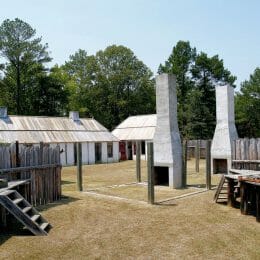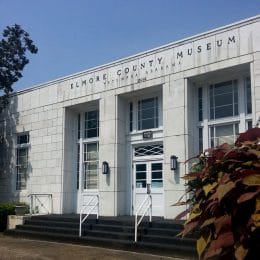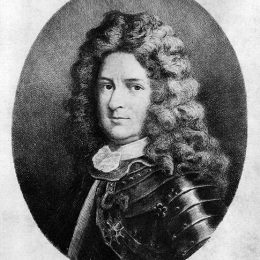Henrí Montault de Monbéraut de Saint-Çivier
Henrí Montault de Monbéraut de Saint-Çivier (1718-1786) was a French political negotiator whose work establishing friendly relations and trust between France and both the Creek and Cherokee Nations is perhaps his greatest legacy. Monbéraut served in the French army and was stationed at Fort Toulouse near present-day Wetumpka, Elmore County, from 1755 to 1759. There, his mastery of many languages as well as his knowledge of the cultural practices of the Creek Confederacy made him the favored contact among many tribal leaders, including those of the Alibamu Indians who welcomed the French to build Fort Toulouse. His work during this pivotal period assisted in the continued Native American preference for the French over the British during the French and Indian War (1754-63). Following this period, Monbéraut was employed by George Johnstone, the first governor of British West Florida, to assist with negotiations among several Native American tribes to normalize trade and codify borders. His Lisloy Plantation just south of Mobile would become home to Bellingrath Gardens in the twentieth century.
Born May 7, 1718, as Henri Elisabeth Aimé Montaut de Saint Sivier, the young Frenchmen went on to be known as Henrí Montault de Monbéraut de Saint-Çivier. He grew up in the rural mountains of France and choose the title of “Montault de Monbéraut” in honor of the Montberaud village. He also held the title of Chevalier after his brother Augustin was granted the noble title by Louis XVI of France. Monbéraut followed tradition and joined the French army, beginning a multi-decade career that eventually brought him to the New World colony of French Louisiana. He rose quickly through the military ranks and spent many of his early service years there. During this time, Monbéraut met his wife, Francoise Laurence Le Blanc, whom he married on November 22, 1744, in New Orleans. Records indicate that they may have had three children.
In 1754, after rising to deputy commander, he received orders to report to Fort Toulouse on the French eastern frontier, where he worked under Commander Monsieur de Massé. The following year, Monbéraut became the fort’s commandant and continued expanding his reputation among Alabama’s indigenous tribes in the hopes of winning the favor of the entirety of the Creek Nation. His work as a negotiator is overwhelmingly remembered as successful, but his tenure at Fort Toulouse ended in controversy, and he was relieved from his appointment in February 1759. According to some records, Monbéraut was finally removed after Jesuit missionaries stationed at the fort complained for several years about his allegedly immoral tactics of gaining trust with the local tribes. Specifics of his approach, however, are not recorded in historical accounts. Another narrative argues that Monbéraut ran the fort to economic excess. What is known, however, is Monbéraut’s paternalistic view towards the native tribes, whom he called his children in speeches and reflections in his memoir. In 1762, Monbéraut ended his career with the French army and resigned from service because of declining health. Despite his many years of service, King Louis XV denied Monbéraut his pension, citing his resignation as the reason.
During the years immediately following his resignation, Monbéraut worked both to reinstate his pension and establish a new source of income. In 1763, he purchased a tract of land at the permission of Louisiana governor Louis Billouart that he would develop into his Lisloy plantation along the Fowl River southwest of Mobile. There, he and his two sons raised a variety of farm animals, including horses, sheep, pigs, and cattle. Records indicate that he owned an estimated 26 enslaved people who labored within the plantation’s gardens, dairies, stables, and the central manor. Monbéraut also owned a second estate north of Mobile along the Tombigbee River, where his enslaved laborers worked for part of the year. A central house as well as slave cabins were also located on the property. In addition, Monbéraut and his sons and son-in-law held property, both commercial and residential and worked by additional enslaved people, in present-day Alabama and Louisiana.
The end of the Seven Years’ War (known as the French and Indian War in the United States) presented both challenges and opportunities for Monbéraut. The 1763 Treaty of Paris ceded all French land east of the Mississippi to Britain and required Monbéraut to either sell his properties in what was now British territory at a loss or renounce his French allegiance to remain in British West Florida as an Englishman, as required by the peace treaty. His notoriety in fostering relationships with indigenous people again came to his benefit.
In 1765, George Johnstone, the first governor of British West Florida, sought his assistance for two congresses, or treaty meetings, that included Choctaw and Chickasaw Indians to be held in Mobile and then in Pensacola with the Upper and Lower Creeks. Johnstone aimed to come to agreements on land grants and trade but needed the assistance of the experienced Monbéraut to succeed. So that year, the British commissioned Monbéraut as Deputy Superintendent of Indian Affairs for British West Florida, under John Stuart, the Superintendent of Indian Affairs. (It remains unclear how Johnstone navigated around employing the Catholic Monbéraut, which was prohibited by British law, but his religion would later become relevant.) Regardless, his successful handling of these treaty negotiations led first to the Treaty with the Choctaws and Chickasaws at Mobile and then the Treaty with the Upper and Lower Creeks at Pensacola. These treaties aimed to establish more peaceful relations and regulate trade, but more importantly, settle land claims in favor of Britain.
The Mobile meetings (from March 26 until April 4) with the Chickasaws and Choctaws were lavish affairs held at Monbéraut’s Mobile residence and attended by Johnstone and Stuart. Monbéraut’s presence was sparse because of illness, but during his attendance he explained in blunt terms that peace between England and France and Spain made the Native Americans subjects of England and that trade for arms, clothing, and other necessities would now be conducted with the British. The treaty also awarded Great Britain a cession of Choctaw land in present-day southwest Alabama and southeast Mississippi while forbidding British settlement on Choctaw lands along the Tombigbee River, roughly north of present-day Coffeeville, Clarke County. The land cession would help establish the primary reference point for the Alabama-Mississippi border.
The Pensacola meetings (May 26-28) were aided by Monbéraut’s son Louis Augustin, who communicated with the very influential Upper Creek chief Yahatatastonake. He was more commonly known as The Mortar by the British and Le Loup, or The Wolf, by the French and was persuaded to attend the Pensacola conference. In a letter to The Mortar, Monbéraut likewise lectured the attending Creeks about the new reality of British rule. Some sources note that the Mobile meetings were a bit more contentious, as The Mortar was suspicious of the British and the Creeks were more insistent in their demands for gifts from the British. The treaty implemented trade regulations meant to protect the Indians from unscrupulous traders while gaining the British a cession of land that likely involved a strip of land 15 miles wide west of Pensacola.
According to Monbéraut’s memoir, his relationship with the British quickly became fraught with distrust and power struggles. He believed that Stuart remained jealous over his reputation and success in negotiations with the tribes. Rumors spread that Monbéraut’s employment would be terminated after he returned to Mobile from Pensacola. Some accounts reported that British officials, including Governor Johnstone, questioned whether or not Monbéraut remained more loyal to the French and the native tribes. As a result, he increasingly believed that Johnstone would ruin him both professionally and financially because of what he personally referred to as his “superiority” with the chiefs, for whom he had long interpreted. Further, Monbéraut argues in his memoir that both Johnstone and Stuart used his Catholic faith as an excuse for terminating his employment rather than admit to their own jealousies. In hopes of untangling himself from the British, Monbéraut began planning his return to France with his family in 1768 after selling his estates. A great deal of his fortune was lost after he sold the Lisloy plantation at a loss and his other properties sold for credit or far less than their value.
In 1769, Monbéraut finally returned to France, with the help of King Louis XVI, despite his known cooperation with Britain. That August, he was granted his long-awaited military pension after presenting his case in court. Little is known of his later years in France, and he is believed to have died in 1786.
Further Reading
- Anderson, Fred. Crucible of War: The Seven Years’ War and the Fate of the Empire in British North America, 1754-1766. New York: First Vintage Books, 2001.
- Hamilton, Peter J. Colonial Mobile. 1910. Reprint, Tuscaloosa: University of Alabama Press, 1976.
- Howard Jr., Milo B., and Robert R. Rea. “Introduction: The Coming of the British.” In The Memoire Justificatif of the Chevalier Montault de Monberaut; Indian Diplomacy in British West Florida, 1763-1765, 8-58. Tuscaloosa: University of Alabama Press, 1965.
- Thomas, Daniel H. Fort Toulouse: The French Outpost at the Alabamas on the Coosa. Tuscaloosa: University of Alabama Press, 1989.












